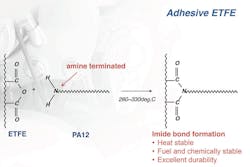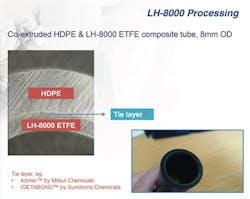Adhesive-grade resins improve fluid handling performance
Next-generation adhesive ethylene tetrafluoroethylene resins (AH-ETFE) improve the performance and durability of fluid handling components used in automotive, chemical and industrial applications. These resins produce multilayer constructions that are extremely conductive, chemical and permeation-resistant, and protect against static buildup.
When manufactured with AH-ETFE resins, components such as liquid and vapor fuel lines, compressor hoses, fuel tanks and filler necks exhibit outstanding performance in any construction. The resins are especially well-suited for automotive fluid handling systems because they help automotive OEMs meet the industry’s increasingly stringent environmental and weight-saving regulations.
Challenges to automotive OEMs
Figure 2. Imide bond at interface | Click to view larger
In 2005, the U.S. Congress created the renewable fuel standard (RFS) program to reduce greenhouse gas emissions, expand the nation’s renewable fuels sector and decrease reliance on imported oil. The RFS requires renewable additives to be blended into transportation fuel in increasing amounts each year, escalating to 36 billion gallons by 2022. Blending mandates in the European Union, Brazil and China likewise have driven biofuel growth in the transportation sector. These fuel compositions have put increasing demands on automotive fuel system components that are made from standard compounds, resulting in fuel hoses that dry out, crack, stretch and soften.
ETFE has a proven track record in automotive fuel line requirements, including resistance to chemical and ethanol mixtures such as CE5, CE10, CM15, CE22, CM30, CE85 and E100; biofuels; and aggressive auto-oxidized fuels with high peroxide numbers. ETFE also provides low permeation rates in accordance with European and U.S. emissions standards Euro4, Euro5, Euro6, LEVII, PZEV and LEVIII.
The new adhesive fluoropolymer grades build on the performance success of ETFE resins in automotive components. They chemically adhere to dissimilar materials, reduce weight and eliminate tie layers in multilayer hose constructions. AH-ETFE compounds also enable hose line constructions to meet stricter emission standards because they have low fuel permeation rates, which decrease as the percentage of alcohol in the fuel mix rises – with rates as low as 0.40 g mm2/m2 day for alcohol fuel content up to 100 percent ethanol.
Adhesive properties
The adhesive functionality of AH-ETFE is polymerized directly in to the backbone of the ETFE. The functional group can interact with reactive groups in other materials, such as amines in polyamides. When in contact with PA12, the imide bond formation results in stability against heat, fuel and chemicals and contributes to its excellent durability (see Figure 1). This imide bond can be observed at the interface of PA12 and the AH-ETFE (see Figure 2).
In addition to the formation of the stable imide bond, AH-ETFE tube systems demonstrate excellent peel strength over a wide range of processing temperatures since the functionality is present not just on the ends of the polymer chain (see Figure 3). As compared to other adhesive chemistries, the bond type and strength of AH-ETFE allows it to continue to perform at elevated temperatures.
Figure 3. The ETFE can be extended with a lower melting class of polymers | Click to view larger
ETFE chemical resistance
The chemical resistance of ETFE is demonstrated in peel strength tests of AH-ETFE and PA12 two-layer hoses. ETFE does not swell in these fuels, which means that even after thousands of hours, the chemical and permeation resistance and bond to the polyamide layer is still intact.
Significantly, the permeation rate of AH-ETFE decreases as ethanol content in fuel increases. At higher alcohol contents, ETFE becomes an even better permeation barrier. This results in improved performance of cars running on E85.
Similarly, two-layer hoses made with AH-ETFE exhibit no change in physical properties when exposed to a variety of automotive process fluids, such as motor oil, LLC, break fluid and automatic transmission fluid. AH-ETFE on the inner layer allows the hose to retain its physical properties including tube length, tensile strength, elongation at break, impact strength and burst pressure. With AH-ETFE protecting the outer layers from chemical permeation, AH-ETFE can be used in multiple fluid-carrying vehicle applications.
Conductive & antistatic compounds
Conductive and antistatic compounds are used to control heat and static electricity. Advanced ETFE conductive compounds are resistant to shear process and minimize losses over time. The significance of resistance to shear means that hose makers can run faster line speeds and thinner ETFE layers and the material will perform just as well. They can also put bends or weld joints in the tubing with no loss in properties. Again, no conductive losses occur over time because ETFE does not swell in fuels. Because of this, the ETFE and carbon network is unaffected by fuel exposure.
Low-melting adhesive ETFE resins
The same adhesive technology that allows AH-ETFE to bond to dissimilar materials such as polyamides has been expanded to an ultra low-melting adhesive ETFE, LH-8000. LH-8000 offers the same reliable chemical resistance of AH-ETFE, but with an ultra-low melting point of 180˚C to 190˚C. LH-8000 can be processed near its ultra-low melting point, or like a typical ETFE near its onset of degradation of 350˚C, allowing for an extremely wide and flexible processing window.
This means that ETFE can now be coextruded with a lower melting class of polymers never before possible (see Figure 3). Because of its ultra-low melting point, hydrogen fluoride gas generation at melt processing temperatures is very low, minimizing damage to the molding equipment. A fluoropolymer layer can be co-extruded with conventional engineering plastics such as HDPE and PA without the need for special corrosion-resistant equipment, thereby reducing the initial investment of processors and molders. As an ultra-low melting resin, it is cost-effective for use in applications such as chemical bags, hot water hoses, rubber hose mandrels, anti-stick conveyor belts, multilayer monofilament, interlayer insulation film for electronic substrates and tubes that convey harsh materials in the chemical, plastics, oil and gas, building and paint industries.
Conclusion
New adhesive-grade fluoropolymer resins provide industry-leading fluid handling performance across an expanded range of tube and hosing applications in the automotive, oil and gas and chemical industries. ETFE resins enable the production of lower melting compounds that offer a wider process window and better compatibility with polyamide nylons for coextrusions, higher upper-end temperature ratings and improved resistance to stress cracks at elevated temperatures.
Katie Sprick is a product and development engineer at AGC Chemicals Americas Inc. For more information, visit agcchem.com.

